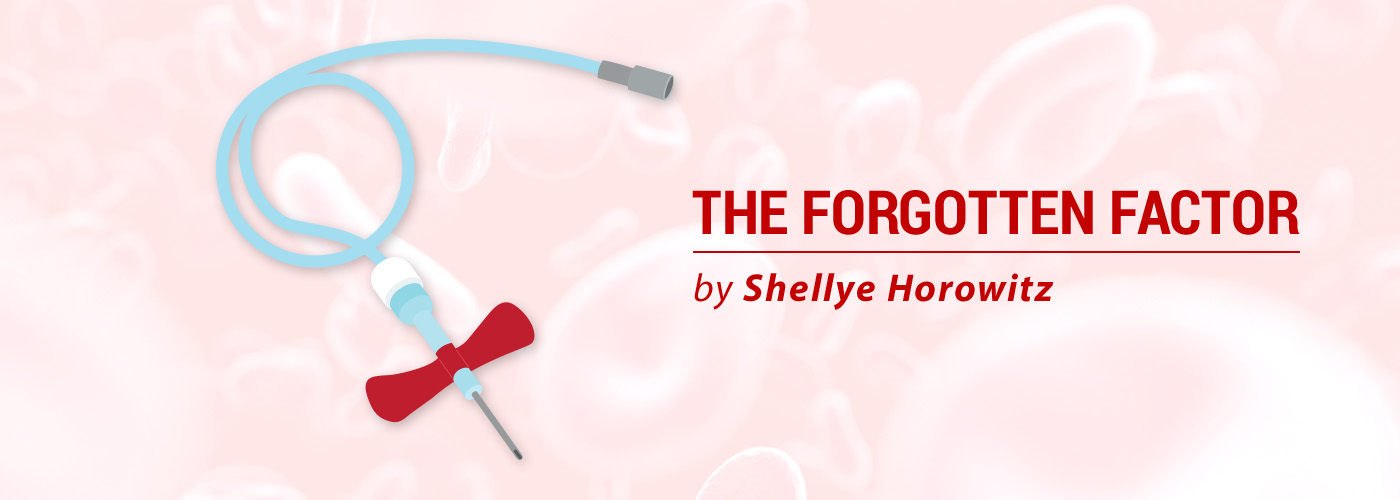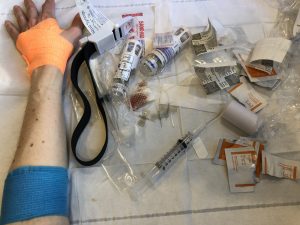How I Mastered the Self-infusion of Factor Products

When I was a young girl, I sat next to my father while he self-infused. I handed him his supplies — butterfly needles, syringes, alcohol, cotton, and medical tape — as he needed them. I watched every step.
The factor was mixed, then drawn into the syringe. He attached and prepped the needle. A tourniquet was fastened around his arm, and the needle poked into his vein. Flash! The blood came when he hit the vein on the first try. (He usually did.)
The tourniquet was loosed and factor pushed in, pulling back every so often to ensure he was still in his vein. When done, my job was to hand him the cotton ball and then fasten it to his arm with medical tape. I was happy to help, and the process fascinated me. Secretly, I looked away when he poked his arm because I hated needles.
At the time, I knew that if I had a son, he could have hemophilia just like my father. I was an obligatory carrier, meaning the genetic mutation is located on the X chromosome my father passed along to me, so there was no question. Doctors told my parents that I was OK — girls were only carriers of hemophilia and did not manifest the disease. Thank heavens we now know differently.
I needed factor, too.
The irony was that as I watched my father infuse factor products to stop bleeding episodes, I needed it, too. My family was unaware, and so were the medical professionals. My ankles hurt, and I hated to run in gym class. I was likely bleeding — but I was called lazy. Teachers and doctors did not understand how much I wanted to run, but my ankles would not cooperate. Running hurt a lot!
Many women do not know how to infuse factor if they need it. Some men with mild or moderate hemophilia also do not know. Most people with severe hemophilia in the U.S. will learn how to self-infuse at their hemophilia treatment center (HTC) or at a summer camp in their youth. It is critical that everyone with hemophilia have the ability to self-infuse their necessary factor medication so they can protect themselves in an emergency.
Improving technique
I gained competence in self-infusion over a three-year period. I was really bad at first. Once, I fell and broke my sacrum and bruised my back. Factor was necessary, and I tried 12 times to hit a vein. I gave up and waited two days until my HTC could coordinate with a local infusion center to place an IV line so that I could infuse the necessary factor. It was awful.
I used to think I had really bad veins, but I soon learned my veins were great, it was my technique that needed help. My veins were small and rolled all the time, so I thought. There was some truth to that, yet I also learned I was not applying strategies to create a different experience. At certain times of day, my veins were small, and at others my veins were huge. Understanding that timing was a part of a good infusion experience made a big difference.
I still have bad days when I may poke myself three or four times, but I usually am successful in infusing my factor. Mostly, I hit the vein on my first try just like my dad used to. I have also learned some tricks along the way.
Self-infusion tips!
- Hydration is a must! Drinking before infusions helps a lot.
- My veins pop more after a shower, making it is easier to infuse.
- Heat packs help veins show more prominently.
- Exercise (if you do not have an injury) also can make veins stand out, though sometimes it is more protective to infuse before exercising.
- When I am calm and free of distractions, I am more likely to hit the vein successfully.
- There is no shame in using a smaller needle. Smaller needles can make poking a lot easier.
- If I concentrate on my goal of hitting the vein, I am less focused on the pain of poking myself.
- Calling a friend for moral support can help an infusion go more smoothly.
- Practicing with saline solution on days when infusion is unnecessary is a low-stress way of improving my skills.
- Knowing when to stop or get help is important — everyone has a bad day, and that is OK.
Don’t give up! Self-infusion is a critical skill. Knowing you can protect yourself in an emergency by administering your own factor medications is empowering and lifesaving. If you do not know how to infuse your factor, consider reaching out to your healthcare provider regarding training opportunities.
***
Note: Hemophilia News Today is strictly a news and information website about the disease. It does not provide medical advice, diagnosis, or treatment. This content is not intended to be a substitute for professional medical advice, diagnosis, or treatment. Always seek the advice of your physician or another qualified health provider with any questions you may have regarding a medical condition. Never disregard professional medical advice or delay in seeking it because of something you have read on this website. The opinions expressed in this column are not those of Hemophilia News Today or its parent company, Bionews Services, and are intended to spark discussion about issues pertaining to hemophilia.







Eileen Brennan
My pic line is in my R arm and I’m right handed.?
Sharon Kende
Bravo. I am trying to self administer vitamin C. I have cancer. My doctor says I need to do so. A nurse trained me. that was two months ago. Ugh
I have tried the methods you mentioned. I am taking a class.
Pray for me! I really need the stuff.
Thank you for this informative article
G Shellye Horowitz
I am so sorry you are going through this. It must be so hard having to learn infusion skills while battling cancer. If I can get the hang of it anyone can! My heart used to pound so hard and I was so nervous and now I do not even think about it. It gets better.